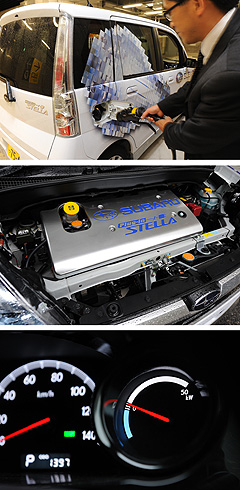Make / Model Search
Future models - Subaru - Stella EVEV power war sparkedMore grunt: Subaru has boosted the power of its Plug-in Stella electric car. Subaru juices up Stella to match Mitsubishi’s i-MiEV21 Apr 2009 By IAN PORTER SUBARU has responded to Mitsubishi’s i-MiEV prototype by boosting the power of its Plug-in Stella by 18 per cent. The upgrade has been incorporated into a batch of 170 vehicles to go on sale in Japan later this year. Test vehicles will also be lent to Japanese prefectural governments and the Japanese Post Office for evaluation. Subaru has upgraded the electric motor from 40kW in the Plug-in Stella prototype that GoAuto drove before the Melbourne International Motor Show, to 47kW – the same as the i-MiEV. Maximum torque is also up, from 150Nm to 170Nm. This leaves the Mitsubishi with an on-paper torque advantage of 10Nm, but the Stella should still have a straight-line performance advantage, thanks to a weight-stripping exercise that has pulled 50kg out of the Stella The Subaru now has a weight advantage of 70kg over the Mitsubishi – equivalent to an adult passenger.  When it comes to range and re-charging, each car has an advantage. The Stella’s maximum range is 80km around town or 100 km cruising, while the Mitsubishi has a maximum cruising range of 160km. When it comes to range and re-charging, each car has an advantage. The Stella’s maximum range is 80km around town or 100 km cruising, while the Mitsubishi has a maximum cruising range of 160km.The Subaru already has a fast-charge system, while Mitsubishi is still working on one for the i-MiEV. The Stella can be recharged two ways. First, a 240-volt household socket in Australia will give a complete charge in four hours. A rapid-charge system using an industrial-strength plug delivers an 80 per cent charge in 15 minutes – good enough for a range of 65km. Subaru claims industry leadership in this area. The Mitsubishi takes seven hours to recharge overnight from a 240-volt outlet. When charged overnight, the Plug-in Stella costs about one cent a kilometre to operate, barely five per cent of the cost of a two-litre car. The latest Plug-in Stella has had its battery pack improved, but more in terms of packaging than power or performance. The lithium-ion battery pack, comprising 16 packs spread under the front and rear seats, has been reduced in size while still retaining the original design’s 9kWh total energy storage. Subaru uses advanced laminated lithium-ion batteries produced by a joint venture between Nissan and electronics giant NEC. Subaru plans to produce around 170 Plug-in Stellas starting around the middle of the year in a program mirroring Mitsubishi’s i-MiEV program. Spokesman for Subaru Australia, David Rowley, said there were no plans to test the Plug-in Stella in Australia. “We hope that, in future, there will be some electric vehicles available for testing in Australia but, at the moment, it is purely a program for the domestic Japanese market,” he said. Read more:First drive: Subaru EV ‘one cent a km’Subaru keeps its cool on EV batteries First Oz drive: Electric i-MiEV coming, ready or not All future models Alfa Romeo Alfa Romeo Abarth Abarth Alpine Alpine Alpina Alpina Audi Audi Aston Martin Aston Martin BMW BMW Bentley Bentley Chery Chery Brabham Brabham Chrysler Chrysler Chevrolet Chevrolet Cupra Cupra Citroen Citroen DS DS Dodge Dodge Fiat Fiat Ferrari Ferrari Foton Foton Ford Ford Great Wall Great Wall FPV FPV Haval Haval GWM GWM Honda Honda Holden Holden Hummer Hummer HSV HSV Infiniti Infiniti Hyundai Hyundai Jaguar Jaguar Isuzu Isuzu Kia Kia Jeep Jeep Land Rover Land Rover Lamborghini Lamborghini Lexus Lexus LDV LDV Mahindra Mahindra Lotus Lotus Mazda Mazda Maserati Maserati Mercedes-AMG Mercedes-AMG McLaren McLaren MG MG Mercedes-Benz Mercedes-Benz Mitsubishi Mitsubishi Mini Mini Opel Opel Nissan Nissan Peugeot Peugeot Pagani Pagani Proton Proton Porsche Porsche Renault Renault Ram Ram Rover Rover Rolls-Royce Rolls-Royce Skoda Skoda Saab Saab SsangYong SsangYong Smart Smart Suzuki Suzuki Subaru Subaru Toyota Toyota Tesla Tesla Volvo VolvoMotor industry news |
Click to shareSubaru modelsResearch Subaru All future models Alfa Romeo Alfa Romeo Abarth Abarth Alpine Alpine Alpina Alpina Audi Audi Aston Martin Aston Martin BMW BMW Bentley Bentley Chery Chery Brabham Brabham Chrysler Chrysler Chevrolet Chevrolet Cupra Cupra Citroen Citroen DS DS Dodge Dodge Fiat Fiat Ferrari Ferrari Foton Foton Ford Ford Great Wall Great Wall FPV FPV Haval Haval GWM GWM Honda Honda Holden Holden Hummer Hummer HSV HSV Infiniti Infiniti Hyundai Hyundai Jaguar Jaguar Isuzu Isuzu Kia Kia Jeep Jeep Land Rover Land Rover Lamborghini Lamborghini Lexus Lexus LDV LDV Mahindra Mahindra Lotus Lotus Mazda Mazda Maserati Maserati Mercedes-AMG Mercedes-AMG McLaren McLaren MG MG Mercedes-Benz Mercedes-Benz Mitsubishi Mitsubishi Mini Mini Opel Opel Nissan Nissan Peugeot Peugeot Pagani Pagani Proton Proton Porsche Porsche Renault Renault Ram Ram Rover Rover Rolls-Royce Rolls-Royce Skoda Skoda Saab Saab SsangYong SsangYong Smart Smart Suzuki Suzuki Subaru Subaru Toyota Toyota Tesla Tesla Volvo VolvoMotor industry news |









Facebook Twitter Instagram